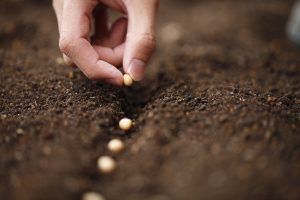Dropping rocks and Sowing Seeds : Creating sustainable cultural change
One of the most challenging pursuits as a Scrum Master or implementation agent of Scrum is establishing sustainable cultural change within an organisation. After having the privilege of attending a session presented by Henrik Kniberg I gained some insight into possible approaches.
Dropping Rocks and Riding Waves
When first joining an organisation as a coach or Scrum master, Scrum implementation will most likely cause some waves. Trying to bring cultural change causes waves. It is supposed to…It is supposed to facilitate change and growth within an organisation. The question is how to facilitate change without tipping the boat. The most effective change is most often not from the outside in ( management forcing change ) but from the inside out (changing the culture from inside with the support of management). Start by dropping a rock and riding the waves.
Dropping a rock in this instance means creating an Agile team that causes disruption within the organisation. Focus on creating a team, culture and environment that has such a positive influence on the organisation, that it cannot be ignored. Make the team the envy of the organisation. Proof that the “magic” of Agile is not just a dream but that it can be a reality within the organisation. Then just ride the waves…
Change is difficult unless the parties involved want to change or even better than that, cannot wait to change. This is the ideal scenario. The repercussions of the new team dropped into the organisation will create interest within the organisation and the coach needs to keep up with the momentum of propagation. The coach needs to make sure that he/she can move where the change is happening next. This might be anywhere or everywhere. If the focus stays on a single team many opportunities will be missed in the process.
The reality though is that there are always sceptics around the corner who will naturally oppose change and try to keep the existing static system in place. Some excuses that typically arise:
- What we are doing is working just fine. Why should we change?
- We are Agile already, however, we do it like ‘THIS’. ‘THIS’ in these instances are typically Frankenstein versions of some or other framework that once remotely resembled Agile.
- We’ll never be able to get as much visibility as we currently do with waterfall.

It is here where the metaphor comes in handy again. Water almost seems to embrace objects in its path. In the same manner, embrace the sceptics and just keep moving. They’ll either come around or be engulfed in the change, that is if the change has proper momentum. An organisation that embraces Agile becomes more like an organism. It will naturally take care of any pain points and in this case, any opposition that becomes detrimental to the system. Either way embracing them creates an opportunity for growth.
Sowing Seeds

Agile is all about mindsets. How can a person’s way of thinking be altered after years of thinking that there us only one way of doing things?
There is the push approach. A mindset can be pushed but that is more destructive than constructive and definitely not in line with the ideology of Scrum. Scrum is by definition a pull system. The participants should be guided and coached to start pulling information as to extract the maximum value of Agility. The organisation should be enticed by the visible value of the framework to grow towards an Agile culture.
Sowing seeds mean making small changes in the hearts and minds of people. Having those seemingly random conversations with deliberate intent to facilitate change. People inherently want to learn and want to grow. For the general working class, Agile sounds like magic when they first make contact with it. It just sounds too good to be true.
Keep spreading the good news to everyone who wants to listen. Once the first rock has been dropped, people will be more open and more interested. Be strategic in choosing what to communicate and when. The highest value of Agile lies in the heart of Agile. Making things better for everyone. Improving production, improving relationships, improving products and improving lives. Use case studies from your past as gateways into the organisation’s future. Keep the level of growth in mind. ShuHaRi can help as a guideline.
ShuHaRi
Shuhari roughly translates to “first learn, then detach, and finally transcend.”
Aikido master Endō Seishirō shihan stated:
“It is known that, when we learn or train in something, we pass through the stages of shu, ha, and ri. These stages are explained as follows. In shu, we repeat the forms and discipline ourselves so that our bodies absorb the forms that our forebears created. We remain faithful to these forms with no deviation. Next, in the stage of ha, once we have disciplined ourselves to acquire the forms and movements, we make innovations. In this process the forms may be broken and discarded. Finally, in ri, we completely depart from the forms, open the door to creative technique, and arrive in a place where we act in accordance with what our heart/mind desires, unhindered while not overstepping laws.”
Specifically when looking at sowing seeds and growing seedlings is an organisation the Shu phase is the focus. When a team and organisation is still in the Shu phase it is very important not to inflict change but to facilitate change. A few guidelines are helpful.
- Don’t inflict help. Fulfil the needs of the organisation by communicating and implementing the right process.
- Have informal conversations with key players. Communicate the dream.
- Use the Scrum Guide and Agile Manifesto (or the documentation that works for you) as the only version of the truth.
- Speak the language. The vocabulary is crucial to facilitate lasting change. If the vocabulary is manipulated, the organisation can quickly redefine the process to fit their vocabulary.
- Highlight the change – Make changes visible to all. Use visual and verbal communication. Show the evolution of the organisation.
- Highlight the value – Show them the magic and show them the charts. Use product demos and velocity charts to make the value tangible.
- Be ready to answer the difficult questions. Sceptics are always around the corner trying to keep the current system in place.
- Be Agile – Be prepared to adapt to the environment and truly be a servant-leader. Whether teams or organisations, everyone wants to be strengthened to become the best version of themselves. Even if they don’t realise it yet.
The ideal to strive towards is to embed Agile into the roots of the organisation. Agility should not just be a way of doing, but a way of being. As soon as the competitive advantage and success of the organisation become dependent on the Agile process and way of doing things, it becomes indispensable. When the company cannot survive without the culture. It has become sustainable.


Elrich’s experiences as business builder and solution implementer, enrich all that he does as experienced Scrum Master.
Keep going. I refer team members here to gain insights!